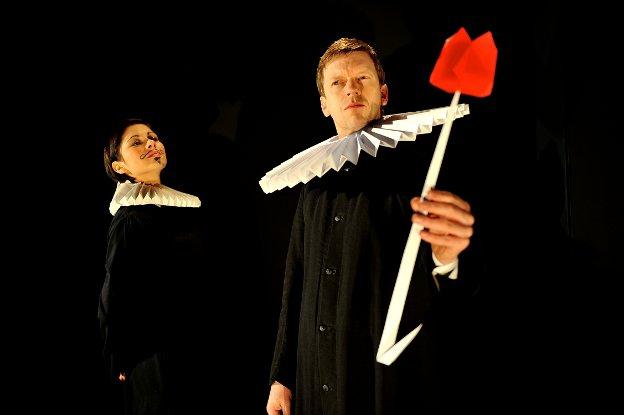Stan’s Cafe’s work subtly renews theatre’s didactic power. In the lineage of the clever but also visceral montage of cinema-like sequences in The Cleansing of Constance Brown, The Just Price of Flowers presents another meaningful juxtaposition of lives and historical sequences inviting the spectator to join ineluctable dots. The play is set in the seventeenth century in the Netherlands at the peak of the tulip mania. The sudden passion of a Dutch merchant for the then exotic tulip drives him, his wife and ultimately his servant to ruin, while his moneylender and his guarantors benefit from a rescue package. The twenty-two tableaux evoking Dutch paintings of the period are introduced in contemporary terms with placards and extracts of newspaper articles about the victims of our current recession.
Against a European background of throbbing austerity tales, set, costumes and props are minimal but purposefully enhanced through the art of origami. The tulips used in the show have certainly not been grown in Kenya to then be packed and labelled in the Netherlands. Neither paper plants nor paper ruff collars are everlasting signs of wealth and their fragile diaphanous aspect enhance the analogy between buried bulbs and volatile bonds or shares failing to materialise.
The main target of this humorous Brechtian tale, complete with narrator/singer and placards, is the system of pension fund investments. The show is an economy masterclass and scene after scene, the audience learns the obscure arcana of finance. No banking operation is dismissed as too technical and the market is fully exposed within the tulip business allegory. A sheer satisfaction is palpable among the audience as it grasps the mechanism that crushes lives all-around. The real life verbatim accounts framing each scene instil an inexorable rhythm to the piece: redundancies, repossessions, bankruptcies… The satisfaction gradually makes room for anguish as there is no way out and the storyline is predictably doomed. However, this is the crux: beyond its didactic efficiency, the piece compels the audience to acknowledge a distressing disgust. It does not suggest a solution to stem the banking tide, but somehow it feels good to take stock rather than bury our bulbs in the sand. This is theatre at its most uncompromising.


